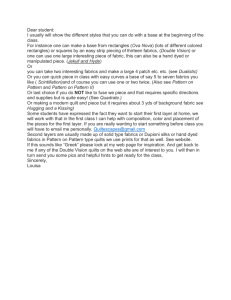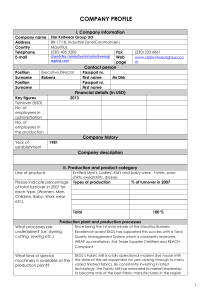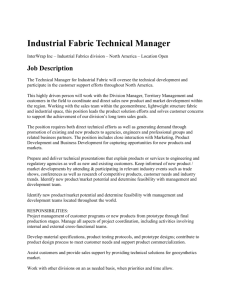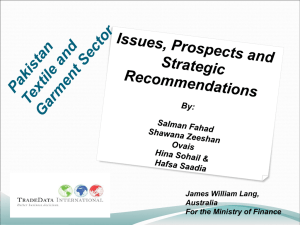Influence of Structural Changes in Cotton Blend Fabrics on Their Mobility
advertisement
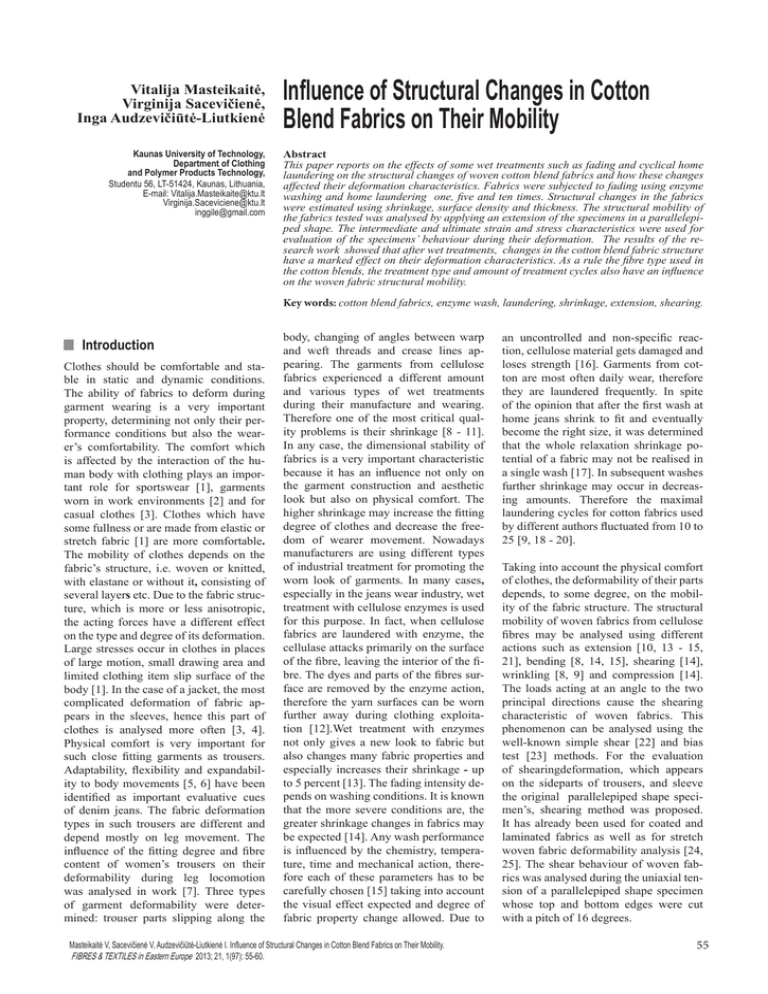
Vitalija Masteikaitė, Virginija Sacevičienė, Inga Audzevičiūtė-Liutkienė Kaunas University of Technology, Department of Clothing and Polymer Products Technology, Studentu 56, LT-51424, Kaunas, Lithuania, E-mail: Vitalija.Masteikaite@ktu.lt Virginija.Saceviciene@ktu.lt inggile@gmail.com Influence of Structural Changes in Cotton Blend Fabrics on Their Mobility Abstract This paper reports on the effects of some wet treatments such as fading and cyclical home laundering on the structural changes of woven cotton blend fabrics and how these changes affected their deformation characteristics. Fabrics were subjected to fading using enzyme washing and home laundering one, five and ten times. Structural changes in the fabrics were estimated using shrinkage, surface density and thickness. The structural mobility of the fabrics tested was analysed by applying an extension of the specimens in a parallelepiped shape. The intermediate and ultimate strain and stress characteristics were used for evaluation of the specimens’ behaviour during their deformation. The results of the research work showed that after wet treatments, changes in the cotton blend fabric structure have a marked effect on their deformation characteristics. As a rule the fibre type used in the cotton blends, the treatment type and amount of treatment cycles also have an influence on the woven fabric structural mobility. Key words: cotton blend fabrics, enzyme wash, laundering, shrinkage, extension, shearing. n Introduction Clothes should be comfortable and stable in static and dynamic conditions. The ability of fabrics to deform during garment wearing is a very important property, determining not only their performance conditions but also the wearer’s comfortability. The comfort which is affected by the interaction of the human body with clothing plays an important role for sportswear [1], garments worn in work environments [2] and for casual clothes [3]. Clothes which have some fullness or are made from elastic or stretch fabric [1] are more comfortable. The mobility of clothes depends on the fabric’s structure, i.e. woven or knitted, with elastane or without it, consisting of several layers etc. Due to the fabric structure, which is more or less anisotropic, the acting forces have a different effect on the type and degree of its deformation. Large stresses occur in clothes in places of large motion, small drawing area and limited clothing item slip surface of the body [1]. In the case of a jacket, the most complicated deformation of fabric appears in the sleeves, hence this part of clothes is analysed more often [3, 4]. Physical comfort is very important for such close fitting garments as trousers. Adaptability, flexibility and expandability to body movements [5, 6] have been identified as important evaluative cues of denim jeans. The fabric deformation types in such trousers are different and depend mostly on leg movement. The influence of the fitting degree and fibre content of women’s trousers on their deformability during leg locomotion was analysed in work [7]. Three types of garment deformability were determined: trouser parts slipping along the body, changing of angles between warp and weft threads and crease lines appearing. The garments from cellulose fabrics experienced a different amount and various types of wet treatments during their manufacture and wearing. Therefore one of the most critical quality problems is their shrinkage [8 - 11]. In any case, the dimensional stability of fabrics is a very important characteristic because it has an influence not only on the garment construction and aesthetic look but also on physical comfort. The higher shrinkage may increase the fitting degree of clothes and decrease the freedom of wearer movement. Nowadays manufacturers are using different types of industrial treatment for promoting the worn look of garments. In many cases, especially in the jeans wear industry, wet treatment with cellulose enzymes is used for this purpose. In fact, when cellulose fabrics are laundered with enzyme, the cellulase attacks primarily on the surface of the fibre, leaving the interior of the fibre. The dyes and parts of the fibres surface are removed by the enzyme action, therefore the yarn surfaces can be worn further away during clothing exploitation [12].Wet treatment with enzymes not only gives a new look to fabric but also changes many fabric properties and especially increases their shrinkage - up to 5 percent [13]. The fading intensity depends on washing conditions. It is known that the more severe conditions are, the greater shrinkage changes in fabrics may be expected [14]. Any wash performance is influenced by the chemistry, temperature, time and mechanical action, therefore each of these parameters has to be carefully chosen [15] taking into account the visual effect expected and degree of fabric property change allowed. Due to Masteikaitė V, Sacevičienė V, Audzevičiūtė-Liutkienė I. Influence of Structural Changes in Cotton Blend Fabrics on Their Mobility. FIBRES & TEXTILES in Eastern Europe 2013; 21, 1(97): 55-60. an uncontrolled and non-specific reaction, cellulose material gets damaged and loses strength [16]. Garments from cotton are most often daily wear, therefore they are laundered frequently. In spite of the opinion that after the first wash at home jeans shrink to fit and eventually become the right size, it was determined that the whole relaxation shrinkage potential of a fabric may not be realised in a single wash [17]. In subsequent washes further shrinkage may occur in decreasing amounts. Therefore the maximal laundering cycles for cotton fabrics used by different authors fluctuated from 10 to 25 [9, 18 - 20]. Taking into account the physical comfort of clothes, the deformability of their parts depends, to some degree, on the mobility of the fabric structure. The structural mobility of woven fabrics from cellulose fibres may be analysed using different actions such as extension [10, 13 - 15, 21], bending [8, 14, 15], shearing [14], wrinkling [8, 9] and compression [14]. The loads acting at an angle to the two principal directions cause the shearing characteristic of woven fabrics. This phenomenon can be analysed using the well-known simple shear [22] and bias test [23] methods. For the evaluation of shearingdeformation, which appears on the sideparts of trousers, and sleeve the original parallelepiped shape specimen’s, shearing method was proposed. It has already been used for coated and laminated fabrics as well as for stretch woven fabric deformability analysis [24, 25]. The shear behaviour of woven fabrics was analysed during the uniaxial tension of a parallelepiped shape specimen whose top and bottom edges were cut with a pitch of 16 degrees. 55 fying the suitability of the parallelepiped shape specimen shearing method for cotton fabric deformability estimation, fabrics of different structural characteristics were used in this work. Basic characteristics of the fabrics tested are shown in Table I. The warp of these fabrics is 100% cotton and the weft is cotton blend with other fibres. B a A l b = 90° l0 D C l b Figure 1. Initial specimen’s shape with main parameters measured. The aim of this work was to apply the parallelepiped shape specimen shearing method for structural mobility analysis of a woven cotton blend fabric and determination of the fabric shear change after some wet treatments, such as fading with enzymes and cyclical home laundering. n Experimental Three cotton blend fabrics which were used for washed production were selected for this work. For the purpose of veri- Nowadays a variety of treatments of clothes from cotton fabrics is used. In order to examine the fabrics’ structural mobility, two types of wet treatments were chosen for this work: fading and laundering. The fading of the fabrics was performed using enzyme wash (Ew). The specimens were washed according to industrial conditions used during professional treatments of garments made from cellulose textile materials: a. The specimens were laundered for about 30 min at a solvent temperature of 50 - 55 °C using 1.5 per cent detergent BEINZYM UL, pH 4.5 - 5.5; b. Rinsing with soda ash to pH 8 - 9 for about 10 min., cold rinse; c. Softening with 1 - 3% TUBINGAL CIS for 15 min at 40 °C, pH 5 - 6; d. Tumble drying at 100 °C, followed by cooling down. aA a) b) c) aA Figure 2. Specimen of fabric A1 clamped in the jaws (a), after extension ε3 = 14% (b) and εn (c). Table 1. Characteristics of fabrics investigated. Weft Weave structure Mass per square meter, g/m2 Thickness, mm 65% cotton 35% polyester 26 19 Plain wave 227 0.36 A2 98% cotton 2% elastane 56 24 ½ Twill 292 0.55 A3 43% cotton 57% flax 20 13 Plain wave 228 0.43 Composition A1 56 Density, cm-1 Warp Fabric The specimens’ treatment was done with a professional drum machine - PRIMUS TEXCOLOUR NC45DM. Additional domestic cyclical laundering was done on purpose to analyse the fabrics’ deformability during clothes wear. Treated (Ew) and non-treated (0) specimens were subjected to domestic laundering one (Dl-1), five (Dl-5) and ten (Dl-10) times. The fabrics were laundered by means of a home automatic washing machine for 30 minutes at 40 °C with ‘Ariel’ detergent and then rinsed for 30 min. at 10 °C. Drying of the specimens was carried out in a free state on a flat surface at room temperature. Structural changes in the fabrics after the wet treatments were evaluated using such characteristics as fabric thickness, mass per square meter and shrinkage. The mass per square meter was determined in accordance with LST EN 12127. The percentage weight loss method is widely applied to evaluate physical and chemical surface changes in the structure of cotton after various treatments [11, 15, 26, 27]. The thickness of the fabric was measured by a thickness meter at a pressure of 0.196 MPa in accordance with the FAST system [23]. Five measurements were made. The coefficients of variation exceeded 2.8% for the weight measurements and 3.5% for the thickness measurements. The fabric shrinkage R after the wet treatments was determined in the warp (I) and weft (II) directions by the standard procedure (LST EN 3759). Three repeated measurements were made for every case and average dimensional changes were expressed to the nearest 0.1%. The coefficient of variation exceeded 1.5%. A method based on the extension of the parallelepiped shaped specimen was used for estimation of the structural mobility of the fabrics tested [24, 25]. This method was chosen on purpose to analyse the fabrics’ deformability that is similar to their behaviour in some parts of clothes [4, 7]. The parallelepiped specimen had the following measurements: 100 mm × 50 mm work zone in the extension direction, and the upper and bottom selvages were cut at α = 16° angle (Figure 1). The experiment was carried out using a Zwick Z/005 tension machine. The cross – head speed was kept at 100 mm/min. After the specimen was fixed in the jaws, it formed two waves in the bias direction. FIBRES & TEXTILES in Eastern Europe 2013, Vol. 21, No. 1 (97) At the beginning of the experiment, the angle β between weft and warp threads was 90°. The distance lo between jaws was chosen as 100 mm. The specimen’s extension distance l till it became rectangular without waves was evaluated using the formula: l = b/tgα (1) where b = 50 mm and α = 16° , with the extension distance equal to l = 14 mm or ε3=14%. During specimen extension, angle β changed from 90° to 90°+α, showing the shearing phenomena of the fabric which often appears on the outer side of trousers [7] or in sleeves [4]. Contrary to expectations, the experiment showed that the extension distance l = 14 mm is not enough because at the final stage the remaining waves on some specimens’ plane are observed (Figure 2.b). Taking into account that the buckling phenomenon on the specimen’s plane did not disappear, further extension εn was carried out till the plane of the specimen had no waves and the shearing process expired (Figure 2.c). Fabrics deformation peculiarities were analysed using parameters received from stress-strain curves (Figure 3). As evident from the curve shape, the specimen’s extension force F increases exponentially. The values of F are small at the initial stage of extension due to the original shape of the specimen; only its zones near the neutral axis A-A begin to deform (Figure 2.a). The structure mobility of the fabrics tested was evaluated using two forces F3 and Fn. For analysis of the specimens’ behaviour during their extension, the calculated strain ε3 and final strain εn were also determined from the curves. Five repeated measurements were made for every case. The coefficients of variation till 6.5% for stress measurements and 14.5% for strain measurements were obtained. All measurements were performed after the specimens had been conditioned in standard atmospheric conditions for 24 hours (20 ± 2 °C temperature, 65 ± 2% RH). n Results and discussion Enzyme wash The test fabrics’ shrinkage R after their enzyme washing (Ew) is presented in FIBRES & TEXTILES in Eastern Europe 2013, Vol. 21, No. 1 (97) Figure 4.a. It is known that the shrinkage degree depends on the fabric structure, fibre content and fabric finish [9, 28]. With reference to the fact that textile materials are under significant lengthwise stress during manufacturing, considerable shrinkage during successive mechanical and chemical processes often occurs in the warp direction [28]. The results show that the shrinkage R of the fabrics tested was larger in the warp direction - about 0.6 - 2.6%. The second reason for higher fabric dimensional change in the warp direction is the presence of more shrinkage yarns: pure cotton (fabric A1 and A2) and pure flax (fabric A3). According to the results, the specimens of fabric A1 shrunk least – 2% in the warp (cotton yarns) and only 0.9% in the weft (polyester yarns) direction. For the rest of the fabrics tested - A2 and A3 the shrinkage R in the warp and weft direction exceeded equally (5.3% and 3.3%, respectively) although their fibre composition in the weft direction is different. Taking into account that during fabric shrinkage fabric’s area density increases, one can expect a larger specimen weight [29]. On the other hand, during a specimen’s chemical and mechanical treatment, lint and dye loss may cause a decrease in fabric weight [9]. Our experiment has shown (Figure 4.b) that the mass per square meter of all fabrics tested increased from 0.9 to 3.5% after their enzyme washing. It was found that maximal changes in characteristic w were shown by cotton/polyester blend fabric A1, whose characteristics in both directions R were high. The impact of enzyme wash on their mass per square meter changes was not significant for the rest of the fabrics tested, the reason for which may be the more intensive influence of enzyme wash on releasing fibre powders and dye parts from the fabric. It can be seen from Figure 4.c that after wet treatment the thickness T of the specimens tested also increased, but not to the same degree. The minimum change in thickness was determined for cotton/elastane fabric A2 – only 1.8%, meanwhile for fabrics A1 and A3 the biggest degree of change in characteristic T was determined as 13.9% and 18.6%, respectively. No satisfactory correlation was obtained between changes in fabric characteristics w and T after enzyme wash. This means that in the case of wet treatment increasing the fabric’s thickness, it was not always followed by a change in its mass per square meter. It is obvious that fewer Fn F3 e3=14 en, % Figure 3. Tensile load-strain curve and main characteristics. changes in both characteristics were shown by fabric A2 containing elastane yarn, while the enzyme wash changed cotton/polyester blend fabric A1’s mass per square meter and cotton/flax blend fabric A3’s thickness more considerably. It is also worth mentioning that in spite of high shrinkage of cotton/elastane fabric, its mass per square meter and thickness after enzyme washing did not change considerably. The specimens’ stresses F3, Fn and ultimate strain εn are presented in Figure 5. As a rule the resistance to deformation is highly dependent on the structure of the fabric, especially the mobility of yarns therein. A structure with a high level of yarn mobility in the fabric generally shows a lower resistance to tension deformation because the movement of yarns allows a wider area of the fabric to carry the load. The essence of fabric deformation used in this work is the nonuniform extension of longitudinal yarns, causing their slippage with respect to each other. Additionally the longitudinal threads extend, with the extension degree depending on the longitudinal threads’ tensile properties. During extension the perpendicular yarns turn about the intersection points and the angle between warp and weft yarns changes. According to the results obtained, fabric A1 in the warp direction showed higher structural stability. Its characteristic F3 reached 5.5 N, while for the other fabrics this characteristic ranged from 0.2 till 2.6 N/cm. The investigation revealed that after enzyme washing the resistance to deformation for the majority of specimens tested decreased by about 36.4 ‑ 73.1%, and only for some speci- 57 6 300 0.6 0 II Ew R, % w, g/m2 4 0 Ew T, mm I 200 0.4 2 0 a) 100 A1 A2 A3 b) Fabrics 0.2 A1 A2 A3 c) Fabrics A1 A2 A3 Fabrics Figure 4. Influence of enzyme wash (Ew) on fabric shrinkage R (a), surface density w (b), and thickness T (c); I-warp direction, II-weft direction; 0-before treatment, Ew-after enzyme wash. 50 a) 3 2 60 0 40 0 Ew 30 Ew 20 1 10 0 0 A1(I) A1(II) A2(I) A2(II) A3(I) A3(II) Fabrics Fabrics b) Fn, N/cm 5 4 n, % F3, N/cm 6 50 40 0 Ew 30 20 10 0 A1(I) A1(II) A2(I) A2(II) A3(I) A3(II) Fabrics Fabrics c) A1(I) A1(II) A2(I) A2(II) A3(I) A3(II) Fabrics Fabrics Figure 5. Fabric stress F3 when ε3 = 14% (a) and characteristics εn (b) and Fn (c) determined after specimen’s plane was without wrinkles; extension in warp (I) and weft (II) directions. mens was an increase in F3 noticed. As evident from Figure 5.a the enzyme wash slightly increased the fabric’s A1 stability in the warp direction (8.3%) and considerably increased the stability of fabric A2 in the weft direction (5.7 times).The possible explanation for F3 increasing may be the influence of the softening agent which was used during the enzyme wash. Since chemical softening increases the surface smoothness of cotton fibres [30], the friction forces of longitudinal yarns against each other and those of transversal yarns at the intersecting points became weaker, and the fabric’s structural mobility increases. One of the main reasons for fabric A2’s increased resistance to shearing after enzyme washing may be elastane fibre stiffening. It should be noted that none of the fabrics tested showed pure shearing when ε3=14 %. More or less sharp waves remained on the plane of the deformed specimen (Figure 2.b), therefore all the specimens were extended till en and the ultimate force Fn was determined. As is evident from the results presented (Figure 5.b), the waves disappear from the plane of fabric A2 slowly, especially in the weft direction. It means that longitudinal thread extension predominates over 58 shearing deformation, which may be explained by elastane fibre presence in this direction. During fabric extension the longitudinal yarns containing elastane fibre elongate more easily than changing angles between two orthogonal yarn directions. The force which is necessary to eliminate the buckling phenomenon from the specimens is presented in Figure 5.c. The results indicate that the lowest values of Fn were received for cotton/flax blend fabric A3, especially when extension was carried out in the warp direction. It means that during the extension of the parallelepiped shaped specimens, the angles β between the warp and weft changed more easily for this fabric (Figure 1). An enormously high Fn was received for fabric A2 in the weft direction after its enzyme wash. It was determined earlier [25] that during the shearing of a specimen of parallelepiped shape, part of the deformation occurs due to thread extension. A possible explanation for the high Fn received for fabric A2 in the weft direction may be the increased extensibility of elastane yarns after the enzyme wash. Therefore more extension distance and extension force is necessary for the elimination of wrinkles on the specimen’s plane. After analysis of the fabrics’ characteristics, such as shrinkage (R) and extension force F3, which reflect the structural mobility of the fabrics, the following conclusions can be made. The specimens with higher shrinkage after enzyme washing showed a more considerable increase in their structural mobility (fabrics A2 and A3 in the warp direction). The lower values of fabric shrinkage stabilize the fabric’s structural mobility, the degree of which also depends on the longitudinal thread composition. The results showed that in the case of synthetic fibre presence in the longitudinal yarns, the mobility of the fabric structure decreases. Domestic laundering The results of the research work show that stress relaxation of the fabrics takes place after every laundering cycle, not only after the first (Figure 6). Fewer shrinkage changes were received for cotton/polyester fabric A1 – maximum 2.5%. For the rest of the fabrics, after ten launderings the characteristic R exceeded 4 - 7% for untreated specimens and 3 - 5% for enzyme washed specimens. It is known that enzyme treated cellulose fabrics of various construction and fibre composition exhibit significant improvement in dimensional stability after washing and drying cycles because the FIBRES & TEXTILES in Eastern Europe 2013, Vol. 21, No. 1 (97) 1 5 Laundering cycles, n 10 7 6 5 4 3 2 1 0 1 b) 0(I) 0(II) Ew(I) Ew(II) R,% 7 6 5 4 3 2 1 0 0(II) Ew(II) R,% R,% a) 0(I) Ew(I) 5 Laundering cycles, n 10 0(I) Ew(I) 7 6 5 4 3 2 1 0 1 c) 0(II) Ew(II) 5 Laundering cycles, n 10 20 15 15 10 5 0 a) 1 0(I) 0(II) Ew(I) Ew(II) 5 Laundering cycles, n 0(I) 0(II) Ew(I) Ew(II) 20 10 5 b) 0(II) Ew(II) 10 5 0 10 0(I) Ew(I) 15 F3,N 20 F3,N F3,N Figure 6. Shrinkage R of fabrics A1 (a), A2(b) and A3 (c) after cyclical laundering. 0 1 5 Laundering cycles, n 10 1 c) 5 Laundering cycles, n 10 Figure 7. Influence of the laundering cycles on the tensile force F3 of fabrics A1 (a), A2 (b) and A3 (c). The influence of domestic laundering on the maximal stress Fn and maximal strain εn of the fabrics tested is presented in Figure 8. For comparison of the results for the non treated (0) and enzyme washed (Ew) specimens before (Dl-0) and after ten laundering cycles (Dl-10) the deformation in the warp direction was chosen. It can be seen that after the cyclical laundering of non treated fabrics A1 and A2, their Fn may increase 2.5 3 times, which could be the reason for FIBRES & TEXTILES in Eastern Europe 2013, Vol. 21, No. 1 (97) The results obtained were compared with results for coated and laminated fabrics obtained using the same deformation method [24]. Analysis of the results showed that deformation F3, causing the fabric shearing phenomenon during their extension, is mostly at the same level 0.5 - 2.5 N/cm, with some exceptions. It is also worth mentioning that none of these two fabric groups showed pure shear after their extension to ε3=14%. In order to eliminate the buckling phenomenon from the specimen’s plane, a minimum strain of εn = 16% for cotton blend fabrics and εn = 18% for coated and laminated fabrics is necessary. n Conclusions The method of parallelepiped shape specimen deformation for analysis of the structural mobility of cotton blend fabrics after their wet treatments was applied in this work. The results of this experiment confirmed that various wet treatments can not only change the structural characteristics of cotton blend fabrics but also 50 50 0(Dl-0) 0(Dl-10) Ew(Dl-0) Ew(Dl-10) 40 30 20 10 40 en, % n, % Characteristic F3 was used for estimation of the fabrics’ structural mobility after their laundering because it was determined at the same extension degree ε3 = 14%. According to the results, the higher resistance to deformation was shown by cotton/polyester blend fabric A1 (Figure 7.a). Additionally it can be noticed that the non treated specimens showed higher stability in the weft direction, while for the enzyme washed specimens this occurred in the warp direction. The best structural mobility was determined for fabric A2, especially in its weft direction (with elastane fibre). more visible wrinkles appearing on the fabric plane during its shear deformation. The laundering of enzyme washed fabrics leads to the softening of their structure, hence lower values of Fn are necessary to complete the shearing process, which is especially natural for fabrics A2 and A3, which are composed mostly of cellulose fibres. It should be noted that elastane fibre situated in the transversal direction of fabric A2 during specimen extension has a significant influence on characteristic εn (Figure 8.b). These results indicate that the strain εn necessary for buckling elimination from the plane of fabric A2 gradually increased after every treatment, despite the force Fn decreasing conversely. Fn, N/cm partial hydrolysis of fabrics with cellulose enzyme results in most effective stress relaxation with minimum weight loss [26]. We received the same results. The faded specimens after washing cycles showed less shrinkage than the untreated ones, with the differences ranging from 0.5 to 3.75%. 30 20 Ew(Dl-0) Ew(Dl-10) 10 0 A1 a) 0(Dl-0) 0(Dl-10) A2 Fabrics 0 A3 b) A1 A2 A3 Fabrics Figure 8. Maximal stress Fn (a) and maximal strain εn (b) of non treated (0) and enzyme washed (Ew) specimens before (Dl-0) and after ten (Dl-10) laundering cycles; extension in warp direction. 59 have a marked influence on their deformability. The following conclusions were obtained: n The results showed that after enzyme wash, due to their shrinkage exceeding to 5%, the area density of cotton blend fabrics increased to 0.9 - 3.5% and the thickness from 1.8 to 15.7%. n In spite of the fabric structure tightening after enzyme wash, the structural mobility of most of the specimens tested increased. The application of a softening agent during enzyme washing may be the reason for the fabrics’ lower resistance to deformation forces. n It is important to note that none of the fabrics tested showed pure shearing when using a calculated strain of 14%, which allowed the parallelepiped specimens’ shape to transform into a rectangular one. The test proved that for buckling phenomenon elimination the specimens experienced a strain which ranged from 16 to 47% for untreated specimens and from 16 to 35% for enzyme washed specimens. The maximal stress in these cases exceeded the maximum to 16 N/cm for most fabrics and only for fabrics with elastane was the increase more marked - to 52.2 N/cm. n The results indicate that the cyclical laundering of cotton blend fabrics increased their shrinkage after every cycle. After ten launderings the characteristic shrinkage exceeded 4 - 7% for untreated specimens and 3 - 5% for enzyme washed specimens. The enzyme washed specimens after the washing cycles showed less shrinkage than the untreated ones, with the differences ranging from 0.5 to 3.75%. n It was determined that enzyme washed cotton fabrics after domestic laundering changed their deformability as well, with their structural stability depending on the fibre composition. Deformation forces acting in the direction of cotton or flax yarns decreased after every laundering cycle and increased when extension was made in the direction of polyester or elastane yarns. References 1. Shishoo R. Textiles in Sport. Woodhead Pulishing Limited, England, 2005. 2. Ng R.; Cheung L; Yu W. Dynamic Ease Allowance in Arm Raising of Functional 60 Garment. SEN’I GAKKAISHI 2008; 64: 236-244. 3. Dongsheng C, Qing, Z. A Study of Clothing Pressure for Men’s Suit Comfort Evaluation. International Journal of Clothing Science and Technology 2003; 15: 320-334. 4. Masteikaitė V, Čironienė V, Domskienė J, Sacevičienė V. Effect of Fabric Rigidity on the Garment Parts Deformability. In: AUTEX 2011, 2011, Mulhouse, pp. 103-106. 5. Rahman O. Understanding Consumers’ Perceptions and Behaviours: Implications For Denim Jeans Design. Journal of Textile and Apparel. Technology and Management 2011; 7: 1-16. 6. Coruh M, Vural T, Coruh E. A scale Development Study to evaluate the physical comfort of Denim Jeans. TEKSTIL ve KONFEKSIYON 2011; 1: 77-81. 7. Maliszewska D, Masteikaitė V, Sacevičienė V. Investigation of Woman’s Trousers Deformation. Innovations in Clothes and Footwear. Monographic series, 2010, XIII, Radom, 347 – 351. 8. Frydrych I, Dziworska G, Matusiak M. Influence of the Kind of Fabric Finishing on Selected Aesthetic and Utility Properties. Fibres&Textiles in Eastern Europe 2003; 11, 3(42): 31-37. 9. Higgins L, Annand SC, Holmes DA, Hall ME. Effects of Various Home Laundering Practices on the Dimensional Stability, Wrinkling, and Other Properties of Plain Woven Cotton Fabrics. Textile Research Journal 2003; 73: 357-366. 10. Lukanova V, Ganchev V. A Possibility for Shrinkage Decrease of Textile Fabrics Made from Cotton and Viscose Fibres. Fibres&Textiles in Eastern Europe 2006; 13, 1(49): 51-53. 11. Valipour P, Mabod M, Nourbakhsk S, Ebadi AG. Shrinkage Behaviour of Corona Discharge Treated Cotton Fabric after Several Laundering. In: AUTEX 2007, 2007, Tampere, pp. 1214-1218. 12. Khedher F, Dhouib S, Msahli S, Sakli F. Study of the influence of matter and finishing treatments on the denim garment shade. International Journal of Clothing Science and Technology 2011; 23: 34-45. 13. Jucienė M, Dobilaitė V, Kazlauskaitė G. Influence of Industrial Washing on Denim Properties. Materials Science 2006; 12: 355-359. 14. Kan CW, Yuen CWM, Lam YL, Chan CK. Effect of Enzymatic Treatment and Reactive Dying on the Low Stress Mechanical Properties Of Linen Fabric. Fibers and Polymers 2009; 10: 325-332. 15. Vasconcelos A, Cavaco-Paulo A. Enzymatic Removal of Cellulose from Cotton/Polyester Fabric Blends. Cellulose 2006; 13: 61-68. 16. Denim garment processing: The ecofriendly way. ExpressTextile. 2003, Indian Express Group, 3. http://www.expresstextile.com/20030320/dyes2.shtml 17. Taylor Mayore A. Technology of Textile Properties. Forbes Publications Ltd. London, 1990. 18. Card A, Moore MA. Ankeny M. Garment Washed Jeans: Impact of Launderings on Physical Properties. International Journal of Clothing Science and Technology 2006; 18: 43-52. 19. Herath CN, Bok Choon Kang. Dimensional Characteristics of Coe Spun Cotton-Spandex 1x1 Rib Knitted Fabrics in Laundering. International Journal of Clothing Science and Technology 2007; 19: 43-58. 20. Militky J, Bajzik V. Influence of Washing/ Ironing Cycles on Selected Properties of Cotton Type Weaves. International Journal of Clothing Science and Technology 1997; 9: 193-199. 21. Mohamed M. Hashem. An Approach towards a Single Pretreatment Recipe for Different Types of Cotton. Fibres & Textiles in Eastern Europe 2007; 15, 2(61): 85-92. 22. Kawabata S. Objective Specification of Fabric Quality. The Textile Machinery Society of Japan, 1982, pp. 31-59. 23. CSIRO Division of Wool Technology, The FAST System of the Objective Measurement of Fabric Properties-Operation, Interpretation and Aplication. CSIRO,-Sydney, 1989. 24. Masteikaitė V, Sacevičienė V. A Method for Mobility Estimation of Textile-polymeric Systems. Fibers and Polymer 2010; 11: 869-876. 25. Sacevičienė V, Masteikaitė V, Klevaitytė R, Audzevičiūtė I. Influence of the Elastane Fibre on the Woven Fabric Structural Mobility. Material Science 2011; 17: 413-416. 26. Valle L, Onos M, Garriga P, Calafell M, Schnitzhofer W, Guebitz GM. Bioscouring of Cotton Fiber with Polygalacturonase Induced in Sclerotium rolfsii using Cellulose and Glucose-pectin. Textile Research Journal 2006; 76: 400-405. 27. Cortez Joao M, Ellis J, Bishop DP. Using Cellulases to Improve the Dimensional Stability of Cellulosic Fabrics. Textile Research Journal 2002; 72: 673-680. 28. Mikučioniene D. The Dimensional Change of Used Pure and Compound Cotton Knitwear Material Science 2004; 10: 93-96. 29. May-Plumlee T, Ji Hyun Bae. Behaviourof Prepared For-Print Fabrics in Digital Printing. Journal of Textile and Apparel. Technology and Management 2005; 4: 1-13. 30. Koženiauskienė J, Daukantienė V. Modification of Textile Materials’ Surface Properties Using Chemical Softener. Material Science 2011; 17: 52-55. Received 28.07.2011 Reviewed 14.02.2012 FIBRES & TEXTILES in Eastern Europe 2013, Vol. 21, No. 1 (97)

